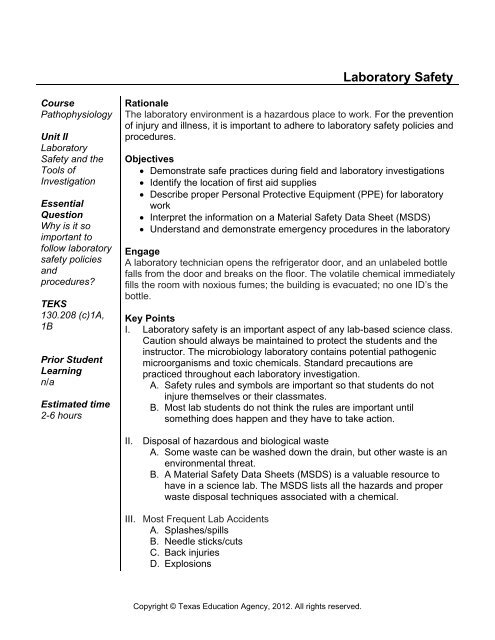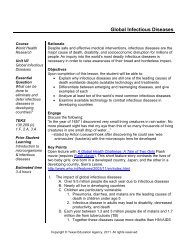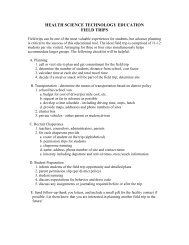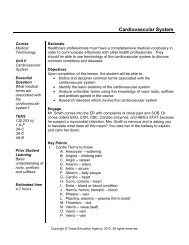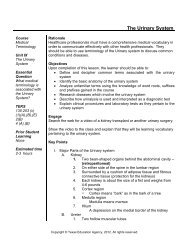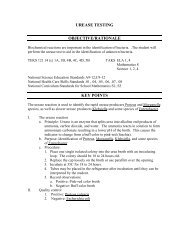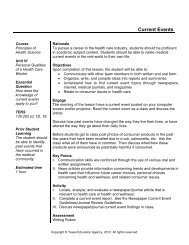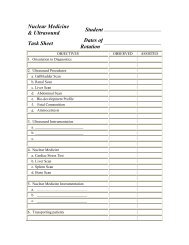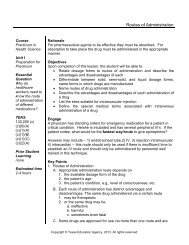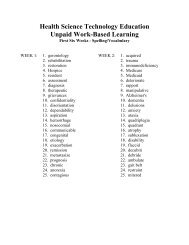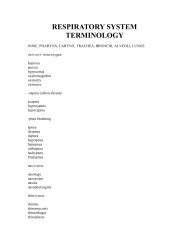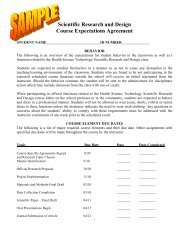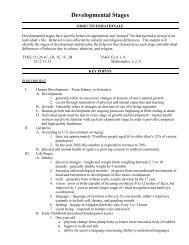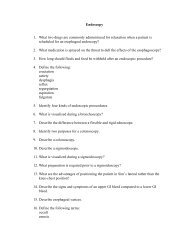Laboratory Safety - Texas Health Science!
Laboratory Safety - Texas Health Science!
Laboratory Safety - Texas Health Science!
You also want an ePaper? Increase the reach of your titles
YUMPU automatically turns print PDFs into web optimized ePapers that Google loves.
<strong>Laboratory</strong> <strong>Safety</strong>CoursePathophysiologyUnit II<strong>Laboratory</strong><strong>Safety</strong> and theTools ofInvestigationEssentialQuestionWhy is it soimportant tofollow laboratorysafety policiesandprocedures?TEKS130.208 (c)1A,1BPrior StudentLearningn/aEstimated time2-6 hoursRationaleThe laboratory environment is a hazardous place to work. For the preventionof injury and illness, it is important to adhere to laboratory safety policies andprocedures.Objectives• Demonstrate safe practices during field and laboratory investigations• Identify the location of first aid supplies• Describe proper Personal Protective Equipment (PPE) for laboratorywork• Interpret the information on a Material <strong>Safety</strong> Data Sheet (MSDS)• Understand and demonstrate emergency procedures in the laboratoryEngageA laboratory technician opens the refrigerator door, and an unlabeled bottlefalls from the door and breaks on the floor. The volatile chemical immediatelyfills the room with noxious fumes; the building is evacuated; no one ID’s thebottle.Key PointsI. <strong>Laboratory</strong> safety is an important aspect of any lab-based science class.Caution should always be maintained to protect the students and theinstructor. The microbiology laboratory contains potential pathogenicmicroorganisms and toxic chemicals. Standard precautions arepracticed throughout each laboratory investigation.A. <strong>Safety</strong> rules and symbols are important so that students do notinjure themselves or their classmates.B. Most lab students do not think the rules are important untilsomething does happen and they have to take action.II. Disposal of hazardous and biological wasteA. Some waste can be washed down the drain, but other waste is anenvironmental threat.B. A Material <strong>Safety</strong> Data Sheets (MSDS) is a valuable resource tohave in a science lab. The MSDS lists all the hazards and properwaste disposal techniques associated with a chemical.III. Most Frequent Lab AccidentsA. Splashes/spillsB. Needle sticks/cutsC. Back injuriesD. ExplosionsCopyright © <strong>Texas</strong> Education Agency, 2012. All rights reserved.
E. FiresF. Toxic fumesG. Mouth pipettingIV. Personal Protective Equipment (PPE)A. Chemical splash gogglesB. Face shieldsC. Lab coatD. Lab apronE. Gloves (selected based on the material being handled and theparticular hazard involved)V. Basic Chemical <strong>Safety</strong>A. Plan ahead1. Have the proper materials and PPE to safely handlechemicals.2. Substitute less toxic chemicals whenever possible.3. Purchase the minimum quantities possible.4. Determine potential hazards beforehand.5. Have a safety plan for emergencies.B. Do not underestimate the risks – read the chemical labels andMSDS beforehand.C. Minimize exposure1. Use the smallest quantities of chemicals possible.2. Never smell chemicals or compounds of unknown toxicity.3. Use fume hoods or other ventilation devices.4. Use carrying containers.5. Do not eat or drink in the lab.D. Be prepared for accidents1. Know the location of eye washes, showers, fire extinguishers,and exits.2. Be prepared to provide basic first aid.3. Anticipate the actions of others.4. Remove all jewelry and “snug-up” all loose fitting clothing andties.VI. A Material <strong>Safety</strong> Data Sheet (MSDS) contains information regardingthe proper procedures for handling, storing, and disposing of a chemicalsubstance.A. An MSDS accompanies all chemicals or kits that containchemicals.B. If an MSDS does not accompany a chemical, many web sites andscience supply companies can supply one, or they can be obtainedfrom www.msdsonline.com.C. Save every MSDS and store them all in a designated file or binderusing a system that is organized and easy to understand.Copyright © <strong>Texas</strong> Education Agency, 2012. All rights reserved.
D. Place the MSDS collection in a central, easily accessible locationknown to all workers and emergency personnel.E. Typically the information is listed in a standardized format (ANSIZ400.1-1998, Hazardous Industrial Chemicals-Material <strong>Safety</strong> DataSheet-Preparation).VII. The National Fire Protection Association (NFPA) Hazard LabelsA. The National Fire Protection Association (NFPA) has developed avisual guide (right) for a number of chemicals pertinent to theMSDS. The ANSI/NFPA 704 Hazard Identification system, theNFPA diamond, is a quick visual review of the health hazard,flammability, reactivity, or special hazards a chemical may present.B. The diamond is broken into four sections (blue, red, yellow, andwhite). The symbols and numbers in the four sections indicate thedegree of hazard associated with a particular chemical or material.<strong>Health</strong> Hazard (Blue)May be fatal on short exposure. Specialized protective4 Dangerequipment required3 Warning Corrosive or toxic. Avoid skin contact or inhalation2 Warning May be harmful if inhaled or absorbed1 Caution May be irritating0 No unusual hazardFlammability (Red)4 Danger Flammable gas or extremely flammable liquid3 Warning Combustible liquid, flashpoint below 100 °F2 Caution Combustible liquid, flashpoint of 100° to 200 °F1 Combustible if heated0 Not combustibleReactivity (Yellow)4 Danger Explosive material at room temperatureMay be explosive if shocked, heated under confinement, or3 Dangermixed with water2 Warning Unstable or may react violently if mixed with water1 Caution May react if heated or mixed with water but not violently0 Stable Not reactive when mixed with waterCopyright © <strong>Texas</strong> Education Agency, 2012. All rights reserved.
WOXWater ReactiveOxidizing AgentSpecial Notice Key (White)VIII. Rules for a safe laboratory environmentA. Applying cosmetics, eating, and drinking are all strictly prohibited inthe laboratory.B. Wear shoes that adequately cover the whole foot; low-heeledshoes with non-slip soles are preferable. Do not wear sandals,open-toed shoes, open-backed shoes, or high-heeled shoes in thelaboratory.C. All personal belongings (books, purses, and backpacks) must bekept away from the work surface.D. Tie back long hair.E. Keep your hands away from your face, eyes, mouth, and bodywhile using chemicals.F. Gloves and goggles must be worn whenever students are workingwith microorganisms.G. If gloves become soiled, change them immediately.H. Always wash your hands after removing gloves.I. Do not put pencils or pens in your mouth while working withmicroorganisms.J. Cover and protect exposed wounds.K. The use of personal audio or video equipment is prohibited in thelaboratory.L. <strong>Laboratory</strong> coats or aprons should be worn at all times duringlaboratory investigations.M. Never use lab glassware for eating or drinking.N. Locate all fire extinguishers in the laboratory.O. Locate the eyewash station. If a sink is used as an eyewashstation, always use cold water to flush your eyes.P. Disinfect the work space before and after each investigation. Usethe 10% bleach solution for disinfectant.Q. Handle all bacterial cultures with extreme caution.R. Use a bulb and pipette; never place your mouth on a pipette.S. Inspect all equipment for damage (cracks, defects, etc.) prior touse; do not use damaged equipment.T. Notify the instructor immediately if a culture has been spilled.U. Place all materials in the appropriate containers upon completion ofthe laboratory investigation.V. Cultures must never leave the laboratory workspace.W. The performance of unauthorized experiments is strictly forbidden.X. If there is a fire drill, turn off all flames and electrical equipment ifpossible, and exit in an orderly fashion. (follow school procedures)Copyright © <strong>Texas</strong> Education Agency, 2012. All rights reserved.
ActivityI. Review and practice correct hand washing procedures.II. Participate in the Lab <strong>Safety</strong> Exercise.III. Complete the Scenarios activity.IV. Complete the MSDS/Chemical Labels activity.V. Complete the <strong>Laboratory</strong> Scavenger Hunt.AssessmentSuccessful completion of activitiesSuccessful completion of the <strong>Laboratory</strong> <strong>Safety</strong> QuizMaterialshttp://www.osha.gov/SLTC/laboratories/index.htmlhttp://absa.org/http://www.cdc.gov/http://www.accessexcellence.org/AE/AEC/AEF/1994/mccadden_safety.phphttp://www.cpsc.gov/cpscpub/pubs/niosh2007107.pdf<strong>Laboratory</strong> <strong>Safety</strong> Guidelines and Contract<strong>Laboratory</strong> <strong>Safety</strong> Letter to ParentsVarious safety rules and letters are provided to be tailored for specificclassroom needsAccommodations for Learning DifferencesFor reinforcement, the student will create a poster illustrating the lab rules.For enrichment the student will write a short story or draw a cartoondepicting characters in unsafe lab situations.For enrichment, the student will create and act out a scenario of an unsafelaboratory practice to demonstrate the dangers of not following safety rulesand regulations. Additional extra credit will be awarded to students whoresearch actual cases involving personal injury in the lab and include themin their presentationNational and State Education StandardsNational <strong>Health</strong> <strong>Science</strong> Cluster StandardsHLC06.01<strong>Health</strong> care workers will understand the existing and potential hazards toclients, co-workers, and self. They will prevent injury or illness through safework practices and follow health and safety policies and procedures.HLC06.02<strong>Health</strong> care workers will understand the fundamentals of wellness and theprevention of disease processes. They will practice preventive healthbehaviors among their clients.Copyright © <strong>Texas</strong> Education Agency, 2012. All rights reserved.
TEKS130.208 (c) (1)(A) demonstrate safe practices during laboratory and fieldinvestigations; and130.208 (c) (1)(B) demonstrate an understanding of the use andconservation of resources and the proper disposal or recycling of materials.<strong>Texas</strong> College and Career Readiness StandardsEnglish Language ArtsII. B. Understand new vocabulary and concepts and use them accurately inreading writing and speaking.III. B. Develop effective speaking styles for both group and one on onesituations.IV. A. Apply listening skills as an individual and as a member of a group in avariety of settings.<strong>Science</strong>1.E.1. Use several modes of expression to describe or characterize naturalpatterns and phenomena. These modes of expression include narrative,numerical, graphical, pictorial, symbolic, and kinesthetic.1.E.2. Use essential vocabulary of the discipline being studied.3.A.1. Use correct applications of writing practices in scientificcommunication.Copyright © <strong>Texas</strong> Education Agency, 2012. All rights reserved.
Lab <strong>Safety</strong>Lab Hygiene• Food and drink: not permitted in the lab. All food and drink should remain outside the lab orin your backpack. This is not negotiable.• Hand washing: wash your hands before leaving the lab.• Tabletops: clean your lab tabletop with soap and water (or disinfectant when working withbacteria) before and after your work.Discard RulesNothing should be casually thrown in the trash or down the sink. Check with your teacher for theproper disposal of waste materials, including chemical solutions, biological wastes (biohazardbags may be required), broken glass, sharps, and other supplies.Personal Protection• Gloves – to protect you from potentially harmful chemicals or organisms, and/or to protectchemicals from you.• <strong>Safety</strong> glasses – worn whenever there is the possibility of a splash injury.• No open-toed shoes when working in the lab.• If the use of a lab coat is required, wear the lab coat only in the lab area.Care of Equipment• Do not use aluminum foil or metal in the microwave.• Balance tubes before using centrifuges.• Follow directions, not only for use, but just as importantly, for cleanup.Accidents in the lab• Report all accidents or incidents immediately to your teacher.• Use the proper safety equipment• Always know where to locate the following safety equipment in your laboratory:1. Fire extinguisher2. Fire blanket3. Eye wash station4. Shower5. MSDS notebookCopyright © <strong>Texas</strong> Education Agency, 2012. All rights reserved.
LABORATORY SAFETY GUIDELINES AND CONTRACTRules for a safe laboratory environment:A. Applying cosmetics, eating, and drinking are strictly prohibited in the laboratory.B. Wear shoes that adequately cover the whole foot; low-heeled shoes with non-slipsoles are preferable. Do not wear sandals, open-toed shoes, open-backed shoes, orhigh-heeled shoes in the laboratory.C. All personal belongings (books, purses, and backpacks) must be kept away from thework surface.D. Tie back long hair.E. Keep your hands away from your face at all times.F. Gloves and goggles must be worn at all times.G. If your gloves become soiled, change them immediatelyH. Always wash your hands after removing gloves.I. Do not put pencils or pens in your mouth while working with microorganisms.J. Cover and protect exposed wounds.K. <strong>Laboratory</strong> coats or aprons should be worn at all times during laboratoryinvestigations.L. Locate all fire extinguishers in the laboratory.M. Never use lab glassware for eating or drinking.N. Locate the eyewash station. If a sink is used as an eyewash station, always use coldwater to flush your eyes.O. Disinfect the work space before and after each investigation. Use the 10% bleachsolution for disinfectant.P. Handle all bacterial cultures with extreme caution.Q. Use a bulb and pipette; never use your mouth on a pipette!R. Notify the instructor immediately if a culture has been spilled.S. Place all materials in the appropriate containers upon completion of the laboratoryinvestigation.T. Inspect all equipment for damage (cracks, defects, etc.) prior to use; do not usedamaged equipment.U. Cultures must never leave the laboratory workspace.V. If there is a fire drill, turn off all flames and electrical equipment, if possible, and exit inan orderly fashion (follow school procedures).I have read and agree to follow the above safety guidelines.I agree to report any accident or injury to the instructor immediately.I will never use any equipment or supplies without obtaining permission from theinstructor.___________________ _____________________ ___________Print Student name Student Signature DateI have read and reviewed the above guidelines with my child.___________________ _____________________ ___________Print Parent Name Parent Signature DateCopyright © <strong>Texas</strong> Education Agency, 2012. All rights reserved.
Commitment to <strong>Safety</strong> in the <strong>Laboratory</strong>To ensure that science experiments are safe and educational, students and teachers should read,discuss, and sign this commitment to laboratory safety agreement.1. Perform the experiments as directed. Do not do anything which is not part of an approvedexperimental procedure.2. Be properly prepared to do the experiment. Read the written procedures in advance andunderstand what you are going to do. Lack of familiarity wastes your time and is a major cause ofinjury. Know the hazards before you do the experiment.3. Never work without instructor supervision. Do not enter the lab if no instructor is present.4. Report all accidents, injuries, and close calls to your instructor immediately. Report anyinappropriate activity to your instructor.5. Wear appropriate protective equipment. ANSI approved splash-proof goggles should be worn atall times. Gloves should be used when appropriate.6. Learn the locations and operation of emergency equipment. This includes eyewashes, safetyshowers, fire extinguishers, fire blankets, sinks, and first aid supplies.7. Act responsibly at all times. No horseplay or fooling around in the lab.8. Wear shoes that cover the whole foot. No sandals or canvas shoes. Clothing should not be loosefitting,especially in the sleeves. Arms, legs, midriffs and buttocks should be covered. Do not wearpolyester clothing or hose/tights; they melt onto skin in a fire.9. Tie back long hair to keep it away from flames and chemicals.10. Never taste a chemical. Check odors, only if instructed to do so, by gently wafting some of thevapor towards your nose with your hand.11. Turn off your Bunsen burner or other heat source whenever you are not using it. Never leave it onunattended. Always warn lab partners when the burner is on.12. Treat burns immediately by putting the burned area under cold water for at least 15 minutes.13. Read the chemical labels carefully. Many mistakes – some dangerous – result from mixing thewrong chemicals. If unsure of a procedure, ask for help before continuing.14. No smoking, eating, or drinking in the lab.15. Dispose of chemicals properly. Pour all wastes into the containers provided unless specificallyinstructed to pour it down the drain. Broken glass goes in special receptacles.16. Never return unused reagents to the reagent bottle. Be careful to take only what you actuallyneed to do the experiment.Copyright © <strong>Texas</strong> Education Agency, 2012. All rights reserved.
17. Clean up spills immediately.18. List your allergies at the bottom of the page. If the experiment deals with something to which youare allergic, consult your instructor. If you are pregnant or have special health concerns, you mayrequest a list of the chemicals used during the semester so that you can discuss them with yourhealthcare provider.19. If you wear contact lenses, indicate this at the bottom of the page. No evidence exists to suggestthat wearing contacts in the lab is dangerous. However, your instructor needs to know if you wearcontacts to properly treat potential chemical splashes.20. Treat all chemicals with the respect they deserve. Know the hazards before you handle thematerial.21. Never take chemicals, supplies, or equipment out of the laboratory without the knowledge andconsent of the instructor. Likewise, do not bring such materials into the lab without the consent ofyour instructor.22. Wash off chemicals splashed or spilled on your skin or body immediately. Wash affected areasfor 15 minutes. Remove contaminated clothing immediately. Notify your instructor.23. Clean your lab bench, put away all equipment and reagents, and wash your hands at the end ofeach lab period.I have read and understand, and agree to follow these safety rules and procedures. I agree to abide byany additional instructions, written or verbal, provided by my instructor.Student’s Signature Student’s Printed Name DateDo you wear contacts? Yes No* List any allergies or medical problems that your instructor should be aware of.I have read and understand, and agree to enforce these safety rules and procedures.Instructor’s Signature Instructor’s Printed Name DateCourse Section SemesterAdapted from <strong>Science</strong> <strong>Safety</strong> Rules and Procedures Agreement by The <strong>Laboratory</strong> <strong>Safety</strong> InstituteCopyright © <strong>Texas</strong> Education Agency, 2012. All rights reserved.
LAB SAFETY CONTRACT♦ I will act responsibly at all times in the laboratory♦ I will follow all instructions about laboratory procedures given by the teacher♦ I will keep my area clean in the laboratory♦ I will wear my safety goggles in the laboratory when instructed to by my teacher♦ I will wear protective clothing in the laboratory when instructed to by my teacher♦ I know where the fire extinguisher is located in the lab and have been trained in its use (at thelaboratory teacher’s discretion)♦ I will immediately notify the teacher of any emergency♦ I will tie back long hair, remove jewelry, and wear shoes with closed toes and heels while in thelaboratory♦ I will never work alone in the laboratory♦ I will not take chemicals or equipment out of the laboratory without permission from the teacher♦ I will never eat or drink in the lab unless instructed to do so by the teacher♦ I will treat all living or preserved specimens carefully and as if they are dangerous♦ I will only handle living or preserved specimens when authorized by the teacher♦ I will not enter or work in the storeroom unless supervised by the teacherA copy of this contract is to be kept in the student’s class notebook.The student and a parent/guardian should sign in the appropriate space below.I, _______________________________________________ have read each of the statements inthe <strong>Science</strong> <strong>Laboratory</strong> <strong>Safety</strong> Contract and understand these safety rules. I agree to abide by thesafety regulations and any additional written or verbal instructions by the ___________________Independent School District or my teacher.Student SignatureDateParent/Guardian SignatureDateCopyright © <strong>Texas</strong> Education Agency, 2012. All rights reserved.
August XX, 20XXDear Parent/Guardian,Your son/daughter is presently enrolled in a course called. Students enrolled in this class will be using a variety of laboratoryequipment and supplies, including bacterial cultures. The student must attend asafety demonstration and pass a written safety exam in order to participate in thelaboratory investigations.Before your son/daughter may use any of the listed equipment, the attachedcontract must be signed and returned. If you have any concerns regarding thelaboratory investigations, please call me duringmy conference period,, at (XXX)XXX-XXXX.Sincerely yours,The InstructorCopyright © <strong>Texas</strong> Education Agency, 2012. All rights reserved.
<strong>Laboratory</strong> <strong>Safety</strong> Exercise1. List as many laboratory safety statements as you can. You should be able to come upwith at least seven of them. Work alone and without talking to anyone else.2. When your instructor indicates, compare and discuss your statements with others in yourgroup. Have a recorder list all of the statements. Pick a maximum of seven rules thatyour group finds to be most important. Rephrase them if necessary so that they are clear.3. Record the seven rules and list a reason for following each of your group's rules.4. Choose a member of your group to present your findings to the class; design a class listof procedures to be followed by all lab participants.Adapted from:http://www.accessexcellence.org/AE/AEC/AEF/1994/mccadden_safety.phpCopyright © <strong>Texas</strong> Education Agency, 2012. All rights reserved.
LABORATORY SAFETY AND EQUIPMENT EXAMNAME:DATE:Please write either the word “safe” or “unsafe” beside each sentence below._______ Eating a candy bar while your laboratory partner assembles the material for thelaboratory investigation._______ Holding a bacterial culture with gloved hands._______ Cleaning your work area with soap and water after a laboratory investigation._______ Lab coats may be worn throughout the school day._______ Never apply make-up while in the laboratory._______ Treat all microorganisms as possible pathogens._______ Eating out of glassware in the laboratory is acceptable, as long as the glassware hasbeen autoclaved._______ Glasses can be laid on the work surface while looking through a microscope._______ Notify the instructor of any accidents in the laboratory._______ Don’t worry about washing your hands, if you have worn gloves throughout thelaboratory investigation._______ Exceptions can be made to standard precautions.Copyright © <strong>Texas</strong> Education Agency, 2012. All rights reserved.
KEY- LABORATORY SAFETY AND EQUIPMENT EXAMPlease write the word safe or unsafe beside each sentence below.unsafesafesafeunsafesafesafeunsafeunsafesafeunsafeunsafeEating a candy bar while your laboratory partner assembles the material for thelaboratory investigation.Holding a bacterial culture with gloved hands.Cleaning your work area with soap and water after a laboratory investigation.Lab coats may be worn throughout the school day.Never apply make-up while in the laboratory.Treat all microorganisms as possible pathogens.Eating out of glassware in the laboratory is acceptable, as long as the glassware hasbeen autoclaved.Glasses can be laid on the work surface while looking through a microscope.Notify the instructor of any accidents in the laboratory.Don’t worry about washing your hands, if you have worn gloves throughout thelaboratory investigation.Exceptions can be made to standard precautions.Copyright © <strong>Texas</strong> Education Agency, 2012. All rights reserved.
<strong>Safety</strong> scenariosIn each of the following situations, write ‘yes’ if the proper safety procedures are being followedand ‘no’ if they are not. Then give reasons for your answers.1. Ellen started weighing chemicals before the teacher came into the room. Her nosestarted itching so she scratched it.2. Since he was wearing glasses, Zach decided not to wear his safety goggles. He startedheating a test tube and slanted it away from his work area and towards the studentsacross the lab table.3. Logan and Monica decided to just dump the leftover chemicals down the sink and run thewater.4. Ron notices that the electrical cord on his hotplate is frayed near the plug. He takes thehotplate to his teacher and asks for permission to use another one.5. Alicia and John left their materials on the lab table when the bell rang for the next class.6. Kathryn missed lunch and thought she would quickly eat a granola bar while she wasworking with her lab partner on their experiment.7. Harris is really thirsty and decides to rinse a beaker with water, refill it with water, andtake a drink.Copyright © <strong>Texas</strong> Education Agency, 2012. All rights reserved.
KEY - <strong>Safety</strong> scenariosIn each of the following situations, write ‘yes’ if the proper safety procedures are being followedand ‘no’ if they are not. Then give reasons for your answers.1. Ellen started weighing chemicals before the teacher came into the room. Her nosestarted itching so she scratched it.No – Keep your hands away from your face at all times2. Since he was wearing glasses, Zach decided not to wear his safety goggles. He startedheating a test tube and slanted it away from his work area and towards the studentsacross the lab table.No – Goggles must be worn at all times, and a test tube should never be heatedand pointed towards another person3. Logan and Monica decided to just dump the leftover chemicals down the sink and run thewater.No - Dispose of chemicals properly. Pour all wastes into the containers providedunless specifically instructed to pour them down the drain.4. Ron notices that the electrical cord on his hotplate is frayed near the plug. He takes thehotplate to his teacher and asks for permission to use another one.Yes - Inspect all equipment for damage (cracks, defects, etc.) prior to use; do notuse damaged equipment.5. Alicia and John left their materials on the lab table when the bell rang for the next class.No - Place all materials in the appropriate containers upon completion of thelaboratory investigation.6. Kathryn missed lunch and thought she would quickly eat a granola bar while she wasworking with her lab partner on their experiment.No – Eating is strictly prohibited in the laboratory.7. Harris is really thirsty and decides to rinse a beaker with water, refill it with water, andtake a drink.No - Never use lab glassware for eating or drinking.Copyright © <strong>Texas</strong> Education Agency, 2012. All rights reserved.
<strong>Laboratory</strong> Scavenger HuntProvide the location and use of listed safety equipment.No. <strong>Safety</strong> Equipment Location Use1 Chemical splashgoggles2 Eye wash station3 <strong>Safety</strong> shower4 Fire blanket5 Fire extinguisher6 First aid kit7 Chemical spill kit8 Fume hood9 Fire alarm10 Emergency exitCopyright © <strong>Texas</strong> Education Agency, 2012. All rights reserved.
Demonstrate your knowledge of safe laboratory practices:1. When should safety goggles be worn?2. What should you do if glassware breaks?3. If you accidentally spill water near electrical equipment, what should you do?4. What precautions should you take when working near an open flame?5. After you clean up your work area, what should you do before leaving the laboratory?6. Is it always appropriate to dispose chemicals by flushing them down the sink? Explain.7. What precautions should you take when using sharp objects like scissors?8. What steps should you take when performing an experiment that involves poisonous orunpleasant vapors?Copyright © <strong>Texas</strong> Education Agency, 2012. All rights reserved.
National Fire Protection AssociationHazard Labels<strong>Health</strong> Hazard (Blue)May be fatal on short exposure. Specialized protective4 Dangerequipment required3 Warning Corrosive or toxic. Avoid skin contact or inhalation2 Warning May be harmful if inhaled or absorbed1 Caution May be irritating0 No unusual hazardFlammability (Red)4 Danger Flammable gas or extremely flammable liquid3 Warning Combustible liquid flash point below 100 °F2 Caution Combustible liquid flash point of 100° to 200 °F1 Combustible if heated0 Not combustibleReactivity (Yellow)4 Danger Explosive material at room temperatureMay be explosive if shocked, heated under confinement, or3 Dangermixed with water2 Warning Unstable or may react violently if mixed with water1 Caution May react if heated or mixed with water but not violently0 Stable Not reactive when mixed with waterWOXSpecial Notice Key (White)Water ReactiveOxidizing AgentCopyright © <strong>Texas</strong> Education Agency, 2012. All rights reserved.
Common <strong>Safety</strong> SymbolsFlammablePoisonExplosiveRadioactiveCorrosiveCompressed GasThe above safety symbols may be replaced by the following symbols that are internationallyaccepted*:FlammableOxidizerExplosiveLow LevelHazardCorrosiveSevere ChronicHazardPoisonEnvironmentalHazard*Globally Harmonized System of Classification and Labeling of Chemicals, United Nations NewYork and Geneva, 2005Copyright © <strong>Texas</strong> Education Agency, 2012. All rights reserved.
Material <strong>Safety</strong> Data Sheets (MSDS)The <strong>Texas</strong> Hazard Communications Act requires that technical bulletins detailing informationabout hazardous chemicals be available for each hazardous chemical stored in a school or workfacility. These sheets must be readily available for reference by employees and laboratorystudents. When reading an MSDS, the following considerations should be taken.The MSDS often outlines only the minimum precautions for safe handling of the chemical. Thus,if the employer’s or reader’s judgment suggests more stringent procedures, those proceduresshould be used.In many cases, the emergency first aid procedures and handling precautions are written to dealwith a worst-case scenario, such as an extensive exposure. Minor accidents may not require thesame level of response. Seek the advice of an expert. React prudently.Do not assume a substance is hazard free if there is no mention of a particular health effect inthe MSDS. A particular hazard may not have been known at the time the MSDS was written.The MSDS should be complete without blank spaces. Question the supplier if blank spaces arefound. If data are not available, the MSDS sheet should indicate so in the space provided.Study the MSDS provided carefully. Answer the questions below in complete sentences on asheet of notebook paper. There are four more questions on chemical labels on the last page ofthis handout.1. Which substance is described by this MSDS?2. What is the chemical formula of this substance?3. List two descriptions of this substance. Why is this information important?4. What are the specific health hazards associated with the substance?6. How would a spill of this substance be handled?7. Which first aid procedures would be used in case of skin contact with this substance?Copyright © <strong>Texas</strong> Education Agency, 2012. All rights reserved.
Copyright © <strong>Texas</strong> Education Agency, 2012. All rights reserved.
Chemical LabelsChemical labels contain a coding system that alerts the user to the specific kinds and degrees ofhazards that the chemical poses. Each color code indicates the particular type of hazard. Blueindicates health hazards, red indicates fire hazards, yellow indicates reactivity hazards, andwhite indicates special hazards. The number within the color code indicates the degree ofdanger (in that hazard category) posed by the chemical. Higher numbers indicate increasedhazards. See the reverse side of this sheet for details.Study the diagram below. Color the diagram appropriately. Review the associated terms.Copyright © <strong>Texas</strong> Education Agency, 2012. All rights reserved.
Chemical Labels: Hazard Coding System*Blue: <strong>Health</strong> Hazard Red: Fire Hazard Yellow: Reactivity HazardSignal Type of possibleinjury4 Short exposure couldcause death orpermanent injury evenif prompt medicalattention is given.3 Short exposure couldcause serioustemporary or residualinjury even thoughprompt medicalattention is given.2 Intense or continuedexposure could causetemporaryincapacitation orpossible residual injuryunless prompt medicalattention is given.1 Exposure could causeirritation but only minorresidual injury even ifno medical attention isgiven.0 Exposure under fireconditions offers nohazard beyond that ofordinary combustibles.Signal Susceptibility ofmaterial to burningSignal Susceptibility torelease of energy4 Rapidly or completely 4 Readily capable ofvaporizes atdetonation oratmospheric pressureexplosiveand normal ambientdecomposition ortemperature or readilyreaction at normaldispersed in air, burnstemperatures andeasily.pressures.3 Liquids and solids3 Capable of detonationignited under almost allor explosive reaction,ambient temperaturebut requires a strongconditions.initiation source, orreacts explosively withwater.2 Must be moderately 2 Normally unstable,heated or exposed toundergoes violenthigh ambientchemical change buttemperatures beforedoes not detonate,igniting.may react violentlywith water or formpotentially explosivemixtures with water.1 Must be preheated1 Normally stable butbefore ignition canunstable at highoccur.temperatures andpressures, may bemoderately waterreactive.0 Will not burn. 0 Normally stable, evenunder fire conditions,not reactive withwater.*Modified from NFPA 704, National Fire Protection AssociationStudy the table above and the chemical label. Answer the following questions.8. Name the type of hazard indicated by each color and the meaning of the numbers shown on thechemical label.9. Describe in general terms a substance for which the chemical label shows the following:Blue 1Red 2Yellow 110. List 3 of the special hazards that may be found in the white section of a chemical label.11. What number and color would be found on the label of a chemical that would react violently withwater or form an explosive mixture with water?Copyright © <strong>Texas</strong> Education Agency, 2012. All rights reserved.
KEY - Material <strong>Safety</strong> Data Sheets (MSDS) / Chemical Labels1. Which substance is described by this MSDS?Sudan IV Solution2. What is the chemical formula of this substance?Mixture3. List two descriptions of this substance. Why is this information important?Red liquid, distinct alcohol odor.4. What are the specific health hazards associated with the substance?Toxic as ethyl alcohol. Not all health aspects have been fully investigated.5. How would a spill of this substance be handled?Absorb on sand or vermiculite. Place in a suitable container.6. Which first aid procedures would be used in case of skin contact with this substance?External: Wash affected parts with copious quantities of water.Internal: Wash mouth; see a physician.Respiratory: Transport to fresh air.Eyes: Wash continuously for 15 minutes; see a physician.7. Name the type of hazard indicated by each color and the meaning of the numbers shown onthe chemical label.<strong>Health</strong> Hazard (Blue)May be fatal on short exposure. Specialized protective4 Dangerequipment required3 Warning Corrosive or toxic. Avoid skin contact or inhalation2 Warning May be harmful if inhaled or absorbed1 Caution May be irritating0 No unusual hazardCopyright © <strong>Texas</strong> Education Agency, 2012. All rights reserved.
Flammability (Red)4 Danger Flammable gas or extremely flammable liquid3 Warning Combustible liquid flash point below 100 °F2 Caution Combustible liquid flash point of 100° to 200 °F1 Combustible if heated0 Not combustibleReactivity (Yellow)4 Danger Explosive material at room temperature3 DangerMay be explosive if shocked, heated under confinement ormixed with water2 Warning Unstable or may react violently if mixed with water1 Caution May react if heated or mixed with water but not violently0 Stable Not reactive when mixed with waterWOXWater ReactiveOxidizing AgentSpecial Notice Key (White)8. Describe in general terms a substance for which the chemical label shows the following:Blue 1 – Caution – may be irritatingRed 2 – Caution – Combustible liquid flash point of 100° to 200 °FYellow 1 – Caution – May react if heated or mixed with water, but not violently9. List 2 of the special hazards that may be found in the white section of a chemical label.Water ReactiveOxidizing Agent10. What number and color would be found on the label of a chemical that would react violentlywith water or form an explosive mixture with water?Yellow 3Copyright © <strong>Texas</strong> Education Agency, 2012. All rights reserved.


